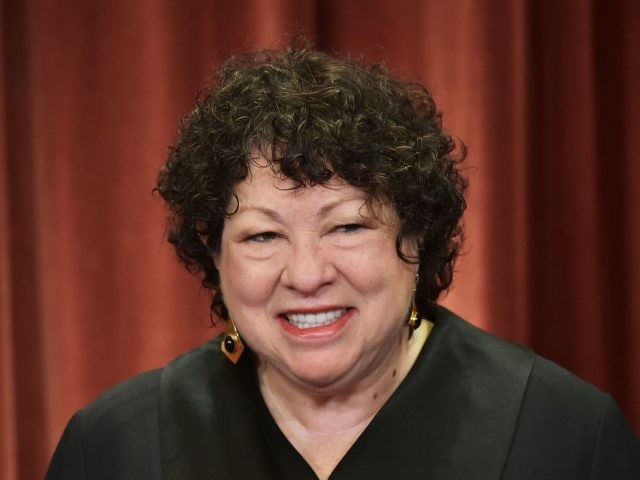Justice Sonia Sotomayor cited sexism as the reason for a Supreme Court rule change during the pandemic, which now mandates that the justices speak one at a time based on seniority during oral arguments.
During a talk with the New York University School of Law on diversity and inclusion, the liberal justice said the rules were changed permanently after a study found that “females were interrupted during oral arguments 141 times while males, only 73. Females interrupted others during oral arguments 37 times, while males interrupted others 177 times” during the 2015 term, the Daily Mail reported.
“Most of the time women say things and they are not heard in the same way as men who might say the identical thing,” she said. Sotomayor noted that the data had “enormous impact” and resulted in Chief Justice John Roberts being “much more sensitive,” the report states.
Sotomayor, who was confirmed in 2009, said her previous solution to fighting interruption was to “interrupt back.” According to the report:
… Women aren’t the only ones to benefit from the format change. Clarence Thomas, the most senior justice on the bench, was known to go years without asking questions during oral arguments,” “But he asked questions in every single argument in the last term and has continued to do so this term.
Sotomayor’s admission of the rule change comes on the heels of a courtroom squabble involving Justice Elena Kagan and Justice Brett Kavanaugh during the oral arguments of the Boston Marathon Bomber death penalty case on Wednesday.
The justices will ultimately decide in July whether to reinstate 28-year-old Dzhokhar Tsarnaev’s death sentence — a verdict rendered in district court but overturned in the U.S. Court of Appeals for the First Circuit.
On Wednesday, the justices and the lawyers in the case mainly debated whether the district court abused its power by excluding evidence related to the unsolved 2011 Waltham murders, which allegedly involved Tsarnaev’s dead brother Tamerlan. Tamerlan and Tsarneav perpetrated the Boston bombings together in 2013, killing three people and injuring more than 260, though Tamerlan died in a shootout with police.
Tsarnaev’s lawyer, Ginger Anders, contended that the Waltham murders show how Tsarnaev’s older brother had a propensity for violence and ultimately ended up playing a role in radicalizing Tsarnaev and manipulating him into participating in the Boston bombings.
The government argued in favor of the district judge’s ruling, saying it is impossible to prove, based off the evidence, whether Tamerlan indeed was the main leader in the Waltham murders, making the basis for the defense’s theory unreliable.
Justices Kagan and Kavanaugh, who are typically opposites in the way they legally interpret the U.S. Constitution, broke new protocol to discuss whether engaging in hypothetical arguments proactively furthered the discussion. Kagan said:
…Assume for me that the evidence was very strong that Tamerlan participated in and indeed had a leading role in the Waltham murders, all right? So assume that the evidence is strong with respect to that. In that case, would the court have committed reversible error by refusing to participate — to admit that evidence?
The government said that in Kagan’s pretend scenario, the government should have admitted the evidence.
“If the defendant was aware of it and there was strong evidence of it, I think the district court should have let it in. Neither of those was true here,” U.S. Deputy Solicitor General Eric Feigin argued.
Kagan further questioned whether it was the district judge’s place to exclude the evidence or if it should have been presented for the jury to decide.
“… It’s the job of the jury, isn’t it, to decide on the reliability of the evidence, to decide whether it’s strong evidence or weak evidence that Tamerlan, in fact, played a leading role in those other gruesome murders?” she posited, before ultimately telling Feigin that the entirety of the government’s cases rests on the “notion that this evidence just wasn’t strong enough” to confirm Tamerlan as the leader in the murders.
Justice Kavanaugh cast doubt on Kagan’s hypothetical line of questioning and brought attention to the district court judge’s argument for excluding the evidence.
“Mr. Feigin, at the beginning of this entire line of questioning, you were asked to assume away something, and I’m confused because you were asked to assume away what I think was the district court’s reasoning here,” Kavanaugh said, adding:
Because the district court said, and I’m quoting, there was ‘insufficient evidence to describe what participation Tamerlan may have had in those events. It is as plausible that Todashev was the bad guy and Tamerlan was the minor actor. There’s just no way of telling who played what role if they played roles.
Kagan jumped in to defend her request for a hypothetical discussion related to the evidence in the Waltham murders, saying the premise “was assumed away because that’s the role of the jury.”
“Well, I think it’s important to discuss the district court’s reasoning. And the district court said, we don’t know what happened,” Kavanaugh rebutted.
The case is United States v. Tsarnaev, No. 20-443 in the Supreme Court of the United States.

COMMENTS
Please let us know if you're having issues with commenting.